Accounting for Managers Assignment 1: Flash Cleaning Services Analysis
VerifiedAdded on 2023/04/21
|17
|4867
|127
Homework Assignment
AI Summary
This document presents a comprehensive solution to an accounting assignment, focusing on the financial analysis of Flash Cleaning Services. It includes detailed journal entries, ledger accounts, and a trial balance, culminating in the preparation of a statement of profit and loss, a statement of financial position, and a statement of changes in equity. The assignment also delves into ratio analysis, calculating and interpreting the current and debt ratios, along with an analysis of the impact of loan repayment on these ratios. Furthermore, the document provides a historical overview of accounting, specifically focusing on the evolution and significance of double-entry bookkeeping, tracing its origins and impact on modern accounting practices. The solution is structured to provide a clear understanding of accounting principles and their practical application.
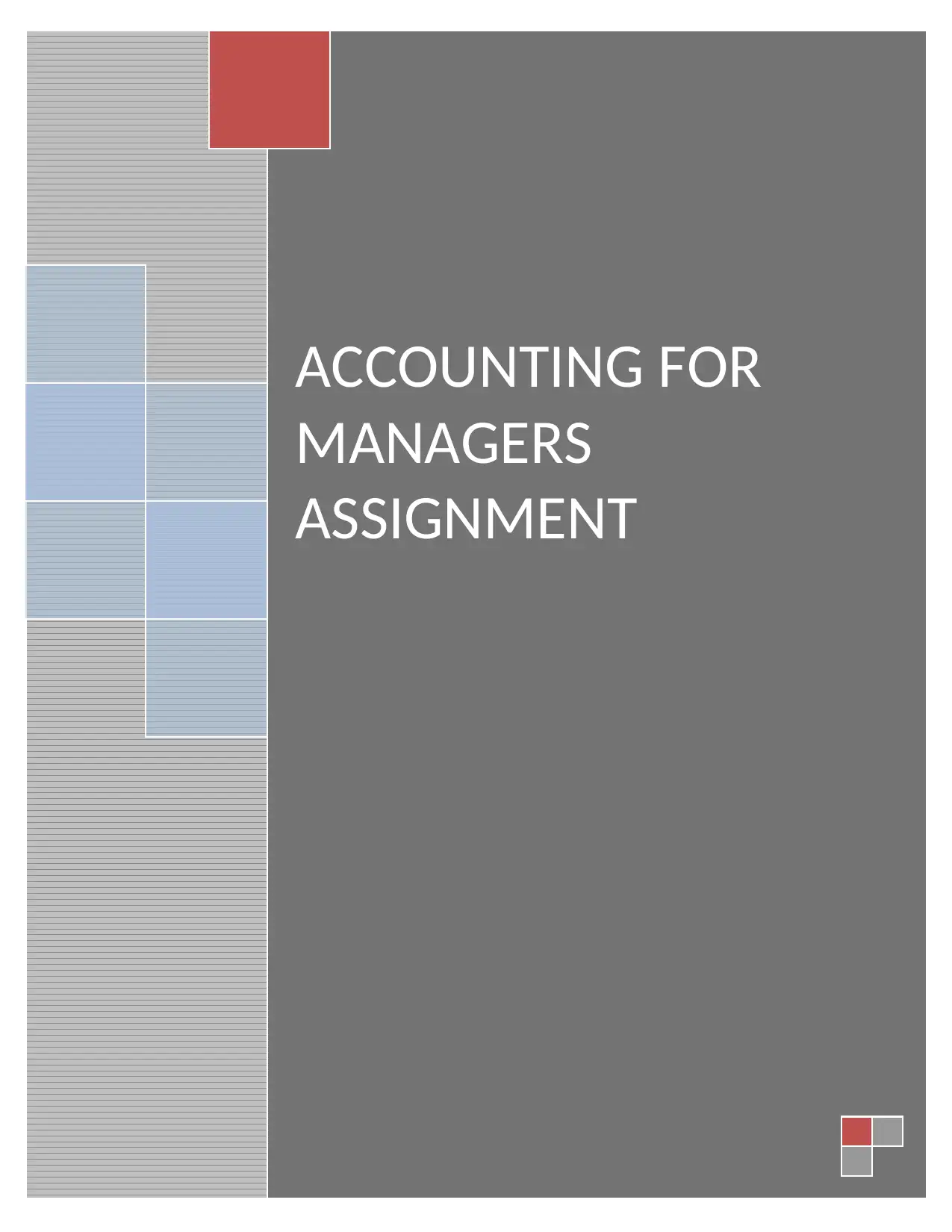
ACCOUNTING FOR
MANAGERS
ASSIGNMENT
MANAGERS
ASSIGNMENT
Paraphrase This Document
Need a fresh take? Get an instant paraphrase of this document with our AI Paraphraser
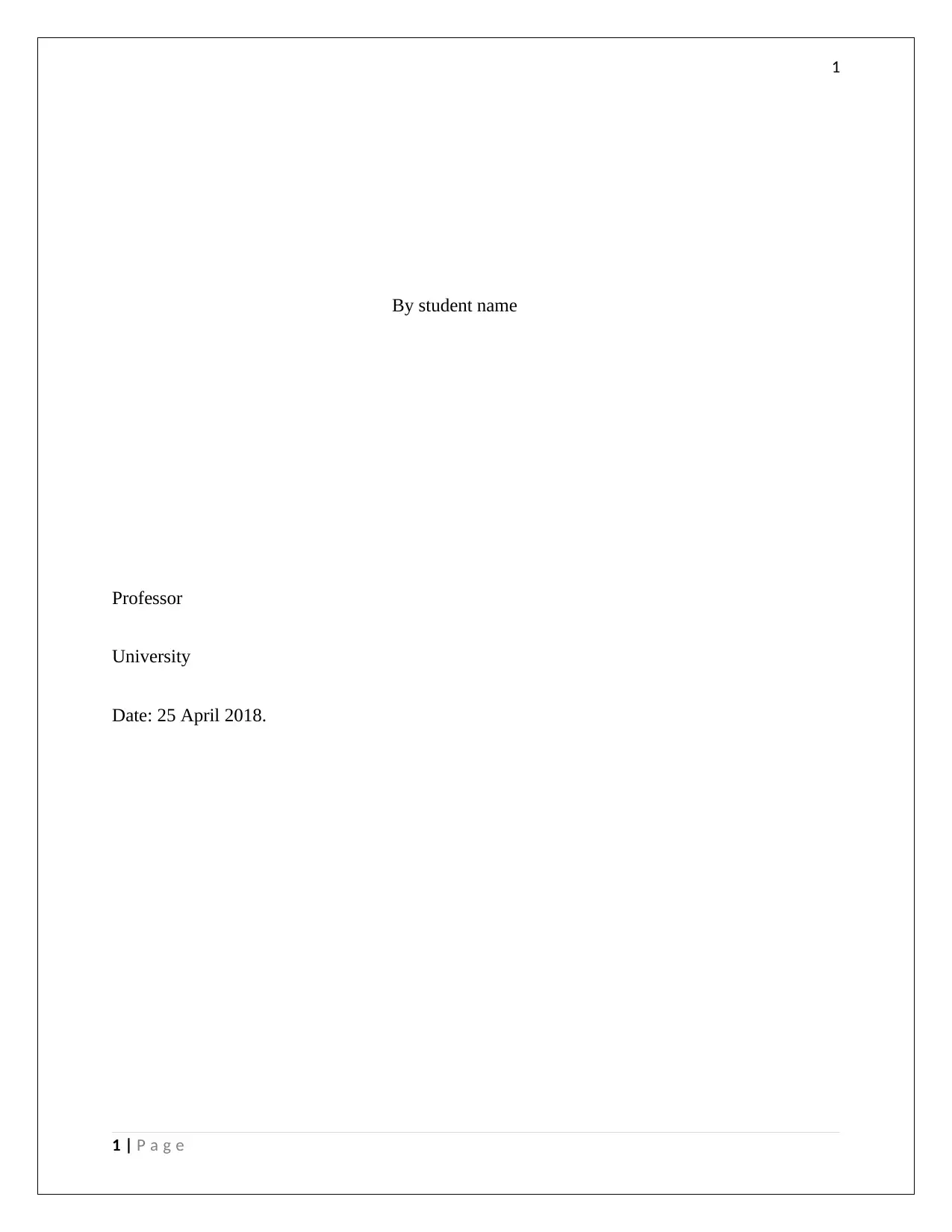
1
By student name
Professor
University
Date: 25 April 2018.
1 | P a g e
By student name
Professor
University
Date: 25 April 2018.
1 | P a g e
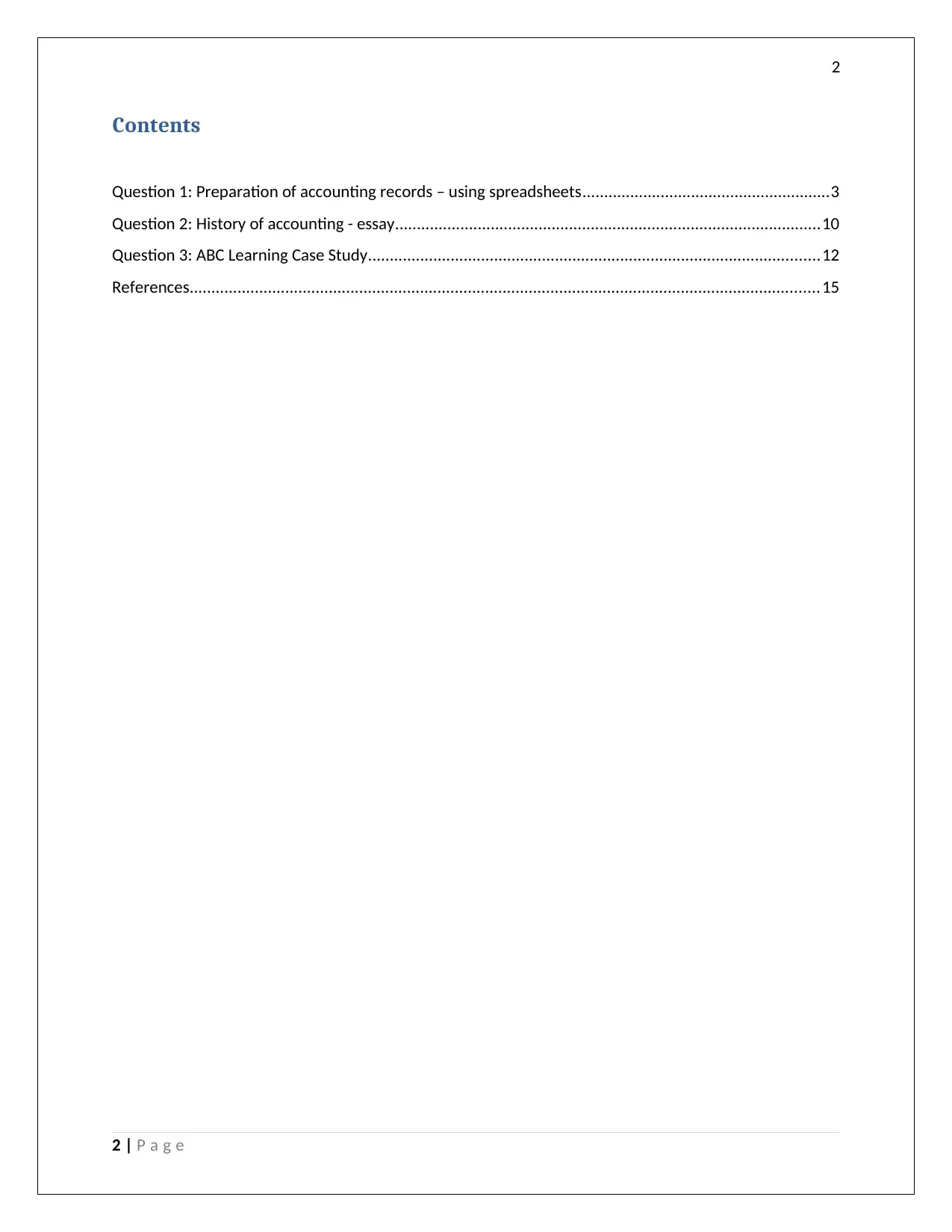
2
Contents
Question 1: Preparation of accounting records – using spreadsheets.........................................................3
Question 2: History of accounting - essay..................................................................................................10
Question 3: ABC Learning Case Study........................................................................................................12
References.................................................................................................................................................15
2 | P a g e
Contents
Question 1: Preparation of accounting records – using spreadsheets.........................................................3
Question 2: History of accounting - essay..................................................................................................10
Question 3: ABC Learning Case Study........................................................................................................12
References.................................................................................................................................................15
2 | P a g e
⊘ This is a preview!⊘
Do you want full access?
Subscribe today to unlock all pages.

Trusted by 1+ million students worldwide
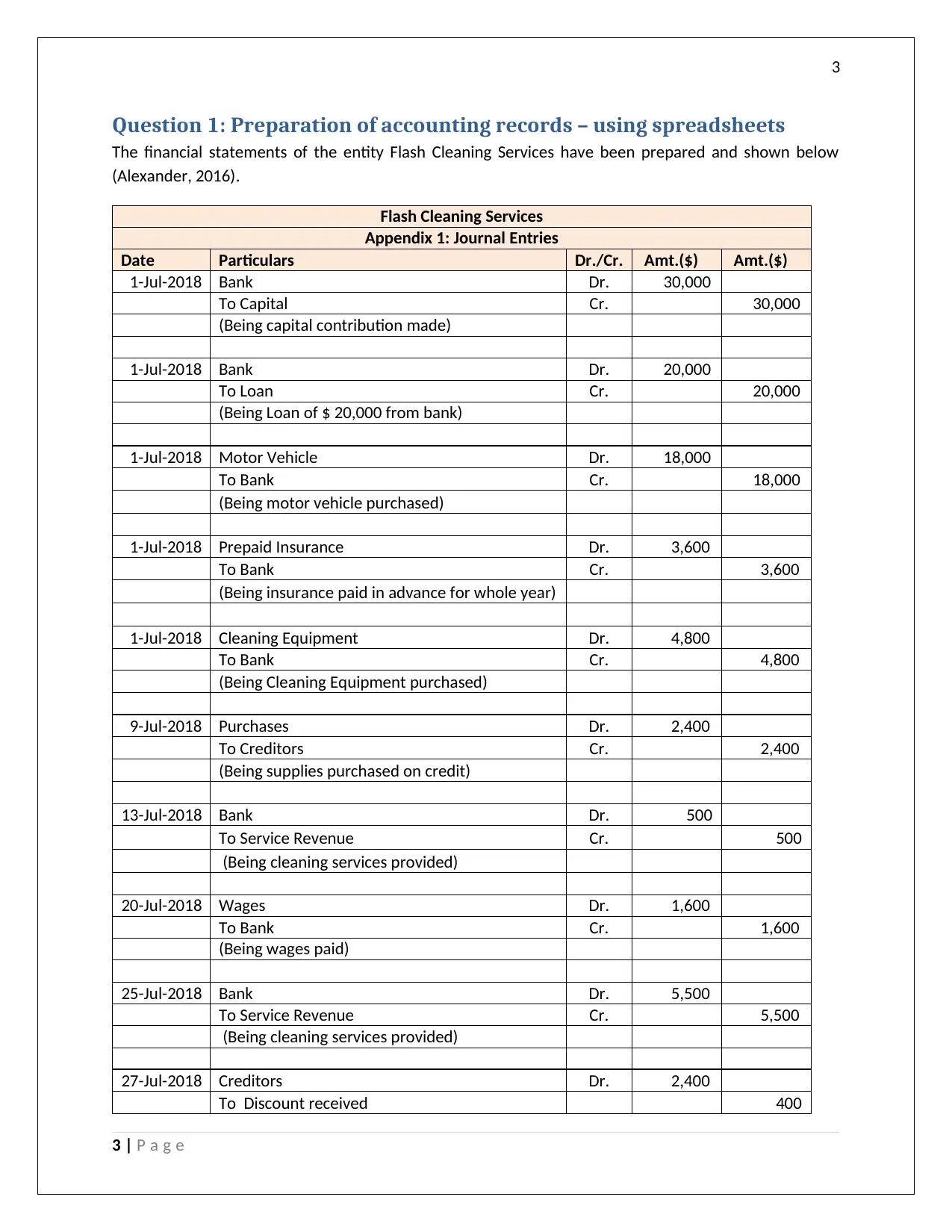
3
Question 1: Preparation of accounting records – using spreadsheets
The financial statements of the entity Flash Cleaning Services have been prepared and shown below
(Alexander, 2016).
Flash Cleaning Services
Appendix 1: Journal Entries
Date Particulars Dr./Cr. Amt.($) Amt.($)
1-Jul-2018 Bank Dr. 30,000
To Capital Cr. 30,000
(Being capital contribution made)
1-Jul-2018 Bank Dr. 20,000
To Loan Cr. 20,000
(Being Loan of $ 20,000 from bank)
1-Jul-2018 Motor Vehicle Dr. 18,000
To Bank Cr. 18,000
(Being motor vehicle purchased)
1-Jul-2018 Prepaid Insurance Dr. 3,600
To Bank Cr. 3,600
(Being insurance paid in advance for whole year)
1-Jul-2018 Cleaning Equipment Dr. 4,800
To Bank Cr. 4,800
(Being Cleaning Equipment purchased)
9-Jul-2018 Purchases Dr. 2,400
To Creditors Cr. 2,400
(Being supplies purchased on credit)
13-Jul-2018 Bank Dr. 500
To Service Revenue Cr. 500
(Being cleaning services provided)
20-Jul-2018 Wages Dr. 1,600
To Bank Cr. 1,600
(Being wages paid)
25-Jul-2018 Bank Dr. 5,500
To Service Revenue Cr. 5,500
(Being cleaning services provided)
27-Jul-2018 Creditors Dr. 2,400
To Discount received 400
3 | P a g e
Question 1: Preparation of accounting records – using spreadsheets
The financial statements of the entity Flash Cleaning Services have been prepared and shown below
(Alexander, 2016).
Flash Cleaning Services
Appendix 1: Journal Entries
Date Particulars Dr./Cr. Amt.($) Amt.($)
1-Jul-2018 Bank Dr. 30,000
To Capital Cr. 30,000
(Being capital contribution made)
1-Jul-2018 Bank Dr. 20,000
To Loan Cr. 20,000
(Being Loan of $ 20,000 from bank)
1-Jul-2018 Motor Vehicle Dr. 18,000
To Bank Cr. 18,000
(Being motor vehicle purchased)
1-Jul-2018 Prepaid Insurance Dr. 3,600
To Bank Cr. 3,600
(Being insurance paid in advance for whole year)
1-Jul-2018 Cleaning Equipment Dr. 4,800
To Bank Cr. 4,800
(Being Cleaning Equipment purchased)
9-Jul-2018 Purchases Dr. 2,400
To Creditors Cr. 2,400
(Being supplies purchased on credit)
13-Jul-2018 Bank Dr. 500
To Service Revenue Cr. 500
(Being cleaning services provided)
20-Jul-2018 Wages Dr. 1,600
To Bank Cr. 1,600
(Being wages paid)
25-Jul-2018 Bank Dr. 5,500
To Service Revenue Cr. 5,500
(Being cleaning services provided)
27-Jul-2018 Creditors Dr. 2,400
To Discount received 400
3 | P a g e
Paraphrase This Document
Need a fresh take? Get an instant paraphrase of this document with our AI Paraphraser
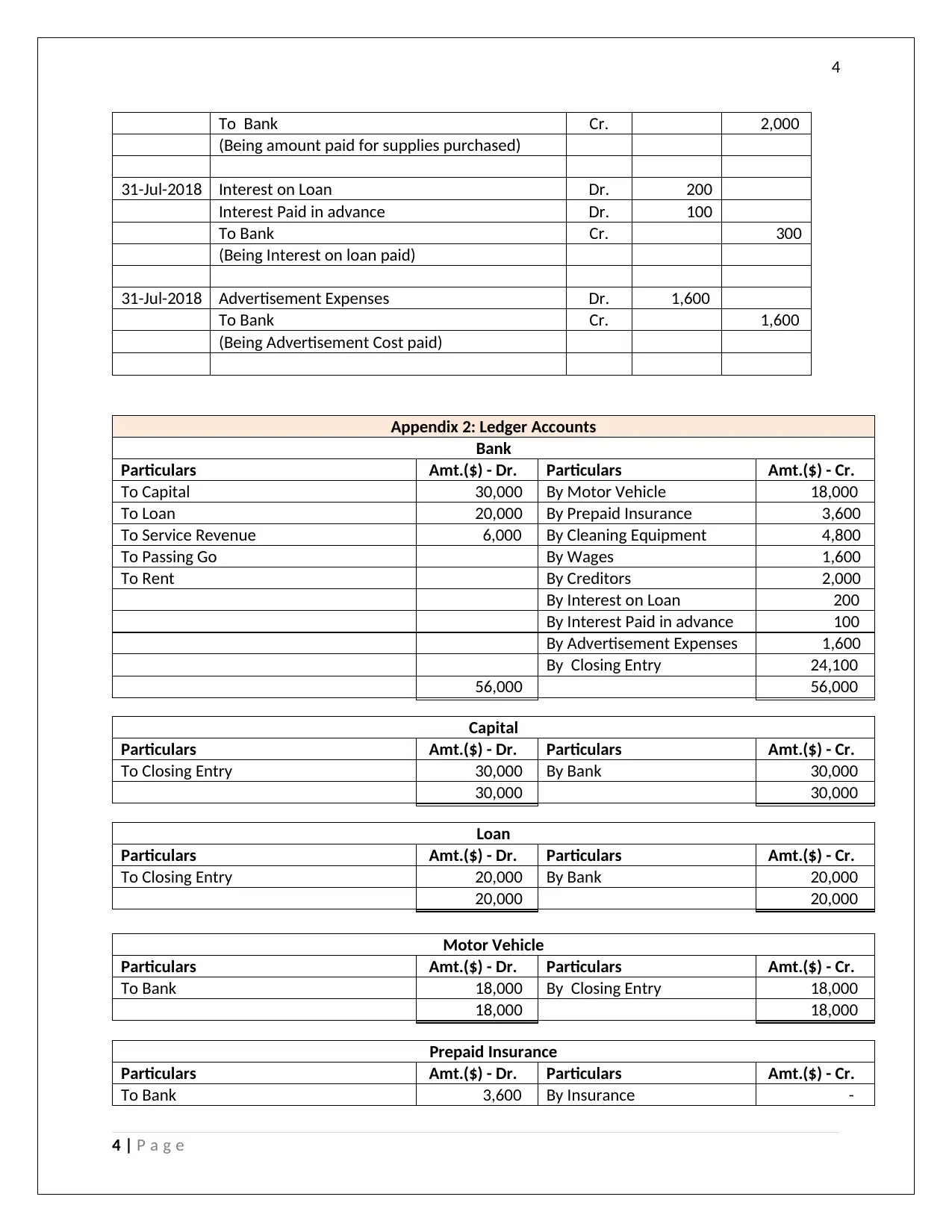
4
To Bank Cr. 2,000
(Being amount paid for supplies purchased)
31-Jul-2018 Interest on Loan Dr. 200
Interest Paid in advance Dr. 100
To Bank Cr. 300
(Being Interest on loan paid)
31-Jul-2018 Advertisement Expenses Dr. 1,600
To Bank Cr. 1,600
(Being Advertisement Cost paid)
Appendix 2: Ledger Accounts
Bank
Particulars Amt.($) - Dr. Particulars Amt.($) - Cr.
To Capital 30,000 By Motor Vehicle 18,000
To Loan 20,000 By Prepaid Insurance 3,600
To Service Revenue 6,000 By Cleaning Equipment 4,800
To Passing Go By Wages 1,600
To Rent By Creditors 2,000
By Interest on Loan 200
By Interest Paid in advance 100
By Advertisement Expenses 1,600
By Closing Entry 24,100
56,000 56,000
Capital
Particulars Amt.($) - Dr. Particulars Amt.($) - Cr.
To Closing Entry 30,000 By Bank 30,000
30,000 30,000
Loan
Particulars Amt.($) - Dr. Particulars Amt.($) - Cr.
To Closing Entry 20,000 By Bank 20,000
20,000 20,000
Motor Vehicle
Particulars Amt.($) - Dr. Particulars Amt.($) - Cr.
To Bank 18,000 By Closing Entry 18,000
18,000 18,000
Prepaid Insurance
Particulars Amt.($) - Dr. Particulars Amt.($) - Cr.
To Bank 3,600 By Insurance -
4 | P a g e
To Bank Cr. 2,000
(Being amount paid for supplies purchased)
31-Jul-2018 Interest on Loan Dr. 200
Interest Paid in advance Dr. 100
To Bank Cr. 300
(Being Interest on loan paid)
31-Jul-2018 Advertisement Expenses Dr. 1,600
To Bank Cr. 1,600
(Being Advertisement Cost paid)
Appendix 2: Ledger Accounts
Bank
Particulars Amt.($) - Dr. Particulars Amt.($) - Cr.
To Capital 30,000 By Motor Vehicle 18,000
To Loan 20,000 By Prepaid Insurance 3,600
To Service Revenue 6,000 By Cleaning Equipment 4,800
To Passing Go By Wages 1,600
To Rent By Creditors 2,000
By Interest on Loan 200
By Interest Paid in advance 100
By Advertisement Expenses 1,600
By Closing Entry 24,100
56,000 56,000
Capital
Particulars Amt.($) - Dr. Particulars Amt.($) - Cr.
To Closing Entry 30,000 By Bank 30,000
30,000 30,000
Loan
Particulars Amt.($) - Dr. Particulars Amt.($) - Cr.
To Closing Entry 20,000 By Bank 20,000
20,000 20,000
Motor Vehicle
Particulars Amt.($) - Dr. Particulars Amt.($) - Cr.
To Bank 18,000 By Closing Entry 18,000
18,000 18,000
Prepaid Insurance
Particulars Amt.($) - Dr. Particulars Amt.($) - Cr.
To Bank 3,600 By Insurance -
4 | P a g e
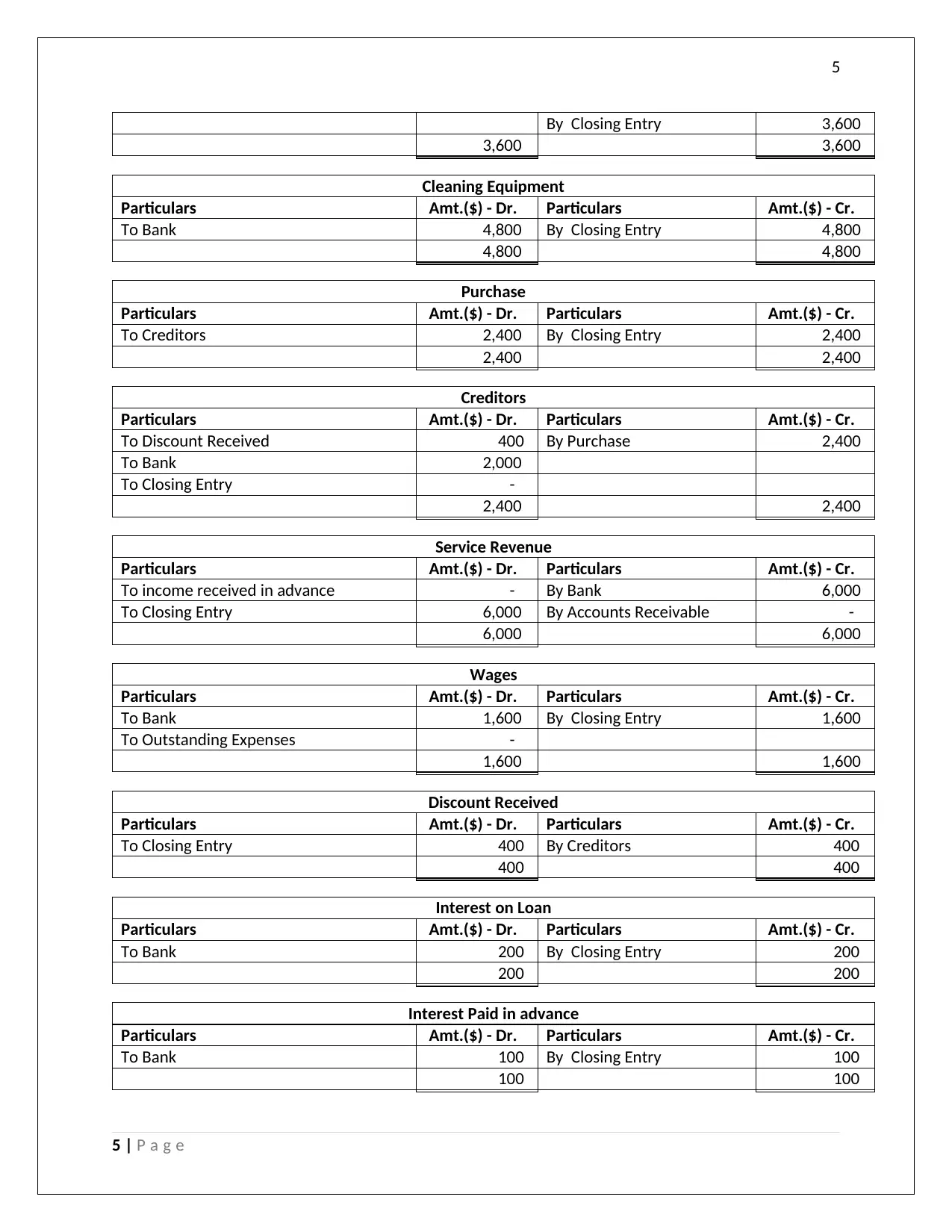
5
By Closing Entry 3,600
3,600 3,600
Cleaning Equipment
Particulars Amt.($) - Dr. Particulars Amt.($) - Cr.
To Bank 4,800 By Closing Entry 4,800
4,800 4,800
Purchase
Particulars Amt.($) - Dr. Particulars Amt.($) - Cr.
To Creditors 2,400 By Closing Entry 2,400
2,400 2,400
Creditors
Particulars Amt.($) - Dr. Particulars Amt.($) - Cr.
To Discount Received 400 By Purchase 2,400
To Bank 2,000
To Closing Entry -
2,400 2,400
Service Revenue
Particulars Amt.($) - Dr. Particulars Amt.($) - Cr.
To income received in advance - By Bank 6,000
To Closing Entry 6,000 By Accounts Receivable -
6,000 6,000
Wages
Particulars Amt.($) - Dr. Particulars Amt.($) - Cr.
To Bank 1,600 By Closing Entry 1,600
To Outstanding Expenses -
1,600 1,600
Discount Received
Particulars Amt.($) - Dr. Particulars Amt.($) - Cr.
To Closing Entry 400 By Creditors 400
400 400
Interest on Loan
Particulars Amt.($) - Dr. Particulars Amt.($) - Cr.
To Bank 200 By Closing Entry 200
200 200
Interest Paid in advance
Particulars Amt.($) - Dr. Particulars Amt.($) - Cr.
To Bank 100 By Closing Entry 100
100 100
5 | P a g e
By Closing Entry 3,600
3,600 3,600
Cleaning Equipment
Particulars Amt.($) - Dr. Particulars Amt.($) - Cr.
To Bank 4,800 By Closing Entry 4,800
4,800 4,800
Purchase
Particulars Amt.($) - Dr. Particulars Amt.($) - Cr.
To Creditors 2,400 By Closing Entry 2,400
2,400 2,400
Creditors
Particulars Amt.($) - Dr. Particulars Amt.($) - Cr.
To Discount Received 400 By Purchase 2,400
To Bank 2,000
To Closing Entry -
2,400 2,400
Service Revenue
Particulars Amt.($) - Dr. Particulars Amt.($) - Cr.
To income received in advance - By Bank 6,000
To Closing Entry 6,000 By Accounts Receivable -
6,000 6,000
Wages
Particulars Amt.($) - Dr. Particulars Amt.($) - Cr.
To Bank 1,600 By Closing Entry 1,600
To Outstanding Expenses -
1,600 1,600
Discount Received
Particulars Amt.($) - Dr. Particulars Amt.($) - Cr.
To Closing Entry 400 By Creditors 400
400 400
Interest on Loan
Particulars Amt.($) - Dr. Particulars Amt.($) - Cr.
To Bank 200 By Closing Entry 200
200 200
Interest Paid in advance
Particulars Amt.($) - Dr. Particulars Amt.($) - Cr.
To Bank 100 By Closing Entry 100
100 100
5 | P a g e
⊘ This is a preview!⊘
Do you want full access?
Subscribe today to unlock all pages.

Trusted by 1+ million students worldwide
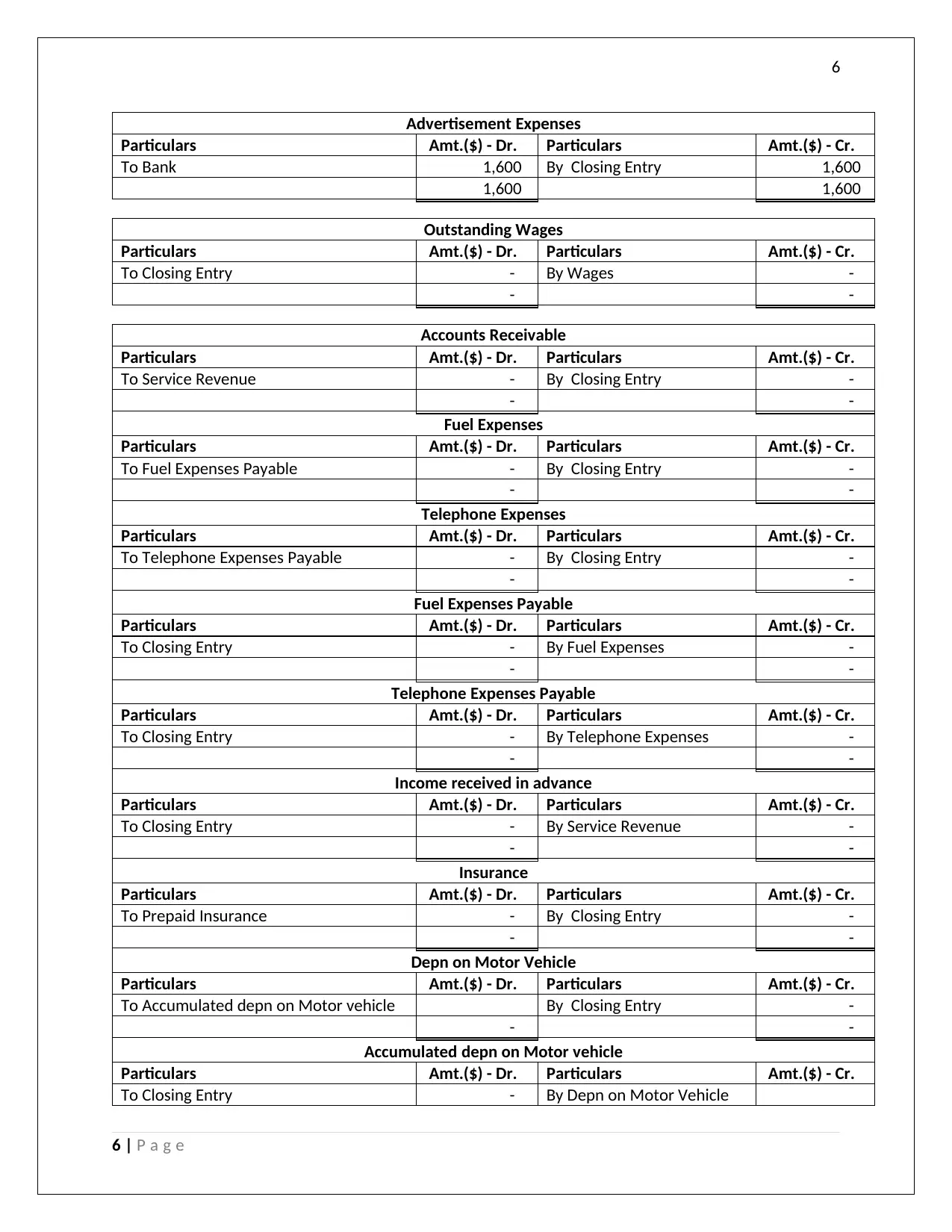
6
Advertisement Expenses
Particulars Amt.($) - Dr. Particulars Amt.($) - Cr.
To Bank 1,600 By Closing Entry 1,600
1,600 1,600
Outstanding Wages
Particulars Amt.($) - Dr. Particulars Amt.($) - Cr.
To Closing Entry - By Wages -
- -
Accounts Receivable
Particulars Amt.($) - Dr. Particulars Amt.($) - Cr.
To Service Revenue - By Closing Entry -
- -
Fuel Expenses
Particulars Amt.($) - Dr. Particulars Amt.($) - Cr.
To Fuel Expenses Payable - By Closing Entry -
- -
Telephone Expenses
Particulars Amt.($) - Dr. Particulars Amt.($) - Cr.
To Telephone Expenses Payable - By Closing Entry -
- -
Fuel Expenses Payable
Particulars Amt.($) - Dr. Particulars Amt.($) - Cr.
To Closing Entry - By Fuel Expenses -
- -
Telephone Expenses Payable
Particulars Amt.($) - Dr. Particulars Amt.($) - Cr.
To Closing Entry - By Telephone Expenses -
- -
Income received in advance
Particulars Amt.($) - Dr. Particulars Amt.($) - Cr.
To Closing Entry - By Service Revenue -
- -
Insurance
Particulars Amt.($) - Dr. Particulars Amt.($) - Cr.
To Prepaid Insurance - By Closing Entry -
- -
Depn on Motor Vehicle
Particulars Amt.($) - Dr. Particulars Amt.($) - Cr.
To Accumulated depn on Motor vehicle By Closing Entry -
- -
Accumulated depn on Motor vehicle
Particulars Amt.($) - Dr. Particulars Amt.($) - Cr.
To Closing Entry - By Depn on Motor Vehicle
6 | P a g e
Advertisement Expenses
Particulars Amt.($) - Dr. Particulars Amt.($) - Cr.
To Bank 1,600 By Closing Entry 1,600
1,600 1,600
Outstanding Wages
Particulars Amt.($) - Dr. Particulars Amt.($) - Cr.
To Closing Entry - By Wages -
- -
Accounts Receivable
Particulars Amt.($) - Dr. Particulars Amt.($) - Cr.
To Service Revenue - By Closing Entry -
- -
Fuel Expenses
Particulars Amt.($) - Dr. Particulars Amt.($) - Cr.
To Fuel Expenses Payable - By Closing Entry -
- -
Telephone Expenses
Particulars Amt.($) - Dr. Particulars Amt.($) - Cr.
To Telephone Expenses Payable - By Closing Entry -
- -
Fuel Expenses Payable
Particulars Amt.($) - Dr. Particulars Amt.($) - Cr.
To Closing Entry - By Fuel Expenses -
- -
Telephone Expenses Payable
Particulars Amt.($) - Dr. Particulars Amt.($) - Cr.
To Closing Entry - By Telephone Expenses -
- -
Income received in advance
Particulars Amt.($) - Dr. Particulars Amt.($) - Cr.
To Closing Entry - By Service Revenue -
- -
Insurance
Particulars Amt.($) - Dr. Particulars Amt.($) - Cr.
To Prepaid Insurance - By Closing Entry -
- -
Depn on Motor Vehicle
Particulars Amt.($) - Dr. Particulars Amt.($) - Cr.
To Accumulated depn on Motor vehicle By Closing Entry -
- -
Accumulated depn on Motor vehicle
Particulars Amt.($) - Dr. Particulars Amt.($) - Cr.
To Closing Entry - By Depn on Motor Vehicle
6 | P a g e
Paraphrase This Document
Need a fresh take? Get an instant paraphrase of this document with our AI Paraphraser
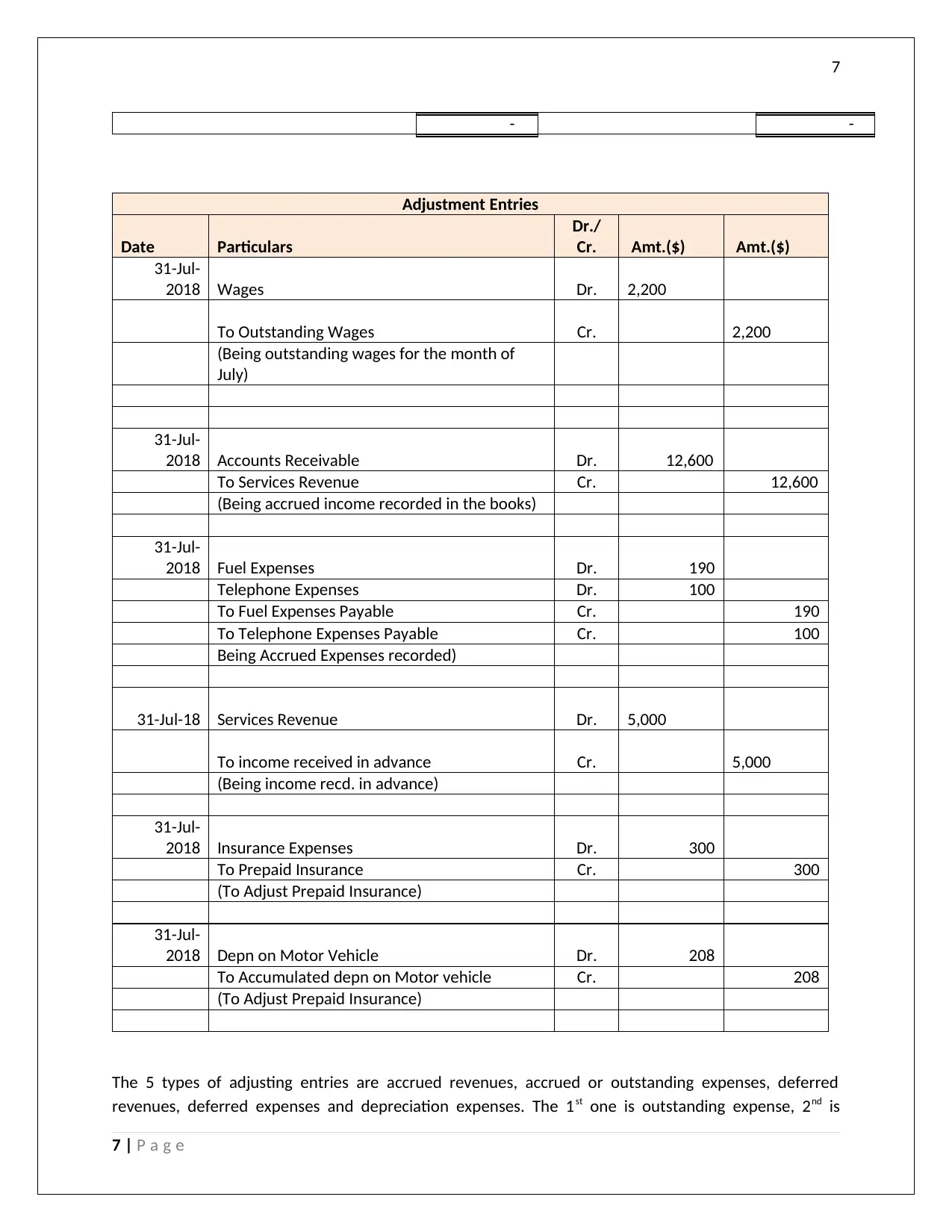
7
- -
Adjustment Entries
Date Particulars
Dr./
Cr. Amt.($) Amt.($)
31-Jul-
2018 Wages Dr. 2,200
To Outstanding Wages Cr. 2,200
(Being outstanding wages for the month of
July)
31-Jul-
2018 Accounts Receivable Dr. 12,600
To Services Revenue Cr. 12,600
(Being accrued income recorded in the books)
31-Jul-
2018 Fuel Expenses Dr. 190
Telephone Expenses Dr. 100
To Fuel Expenses Payable Cr. 190
To Telephone Expenses Payable Cr. 100
Being Accrued Expenses recorded)
31-Jul-18 Services Revenue Dr. 5,000
To income received in advance Cr. 5,000
(Being income recd. in advance)
31-Jul-
2018 Insurance Expenses Dr. 300
To Prepaid Insurance Cr. 300
(To Adjust Prepaid Insurance)
31-Jul-
2018 Depn on Motor Vehicle Dr. 208
To Accumulated depn on Motor vehicle Cr. 208
(To Adjust Prepaid Insurance)
The 5 types of adjusting entries are accrued revenues, accrued or outstanding expenses, deferred
revenues, deferred expenses and depreciation expenses. The 1st one is outstanding expense, 2nd is
7 | P a g e
- -
Adjustment Entries
Date Particulars
Dr./
Cr. Amt.($) Amt.($)
31-Jul-
2018 Wages Dr. 2,200
To Outstanding Wages Cr. 2,200
(Being outstanding wages for the month of
July)
31-Jul-
2018 Accounts Receivable Dr. 12,600
To Services Revenue Cr. 12,600
(Being accrued income recorded in the books)
31-Jul-
2018 Fuel Expenses Dr. 190
Telephone Expenses Dr. 100
To Fuel Expenses Payable Cr. 190
To Telephone Expenses Payable Cr. 100
Being Accrued Expenses recorded)
31-Jul-18 Services Revenue Dr. 5,000
To income received in advance Cr. 5,000
(Being income recd. in advance)
31-Jul-
2018 Insurance Expenses Dr. 300
To Prepaid Insurance Cr. 300
(To Adjust Prepaid Insurance)
31-Jul-
2018 Depn on Motor Vehicle Dr. 208
To Accumulated depn on Motor vehicle Cr. 208
(To Adjust Prepaid Insurance)
The 5 types of adjusting entries are accrued revenues, accrued or outstanding expenses, deferred
revenues, deferred expenses and depreciation expenses. The 1st one is outstanding expense, 2nd is
7 | P a g e
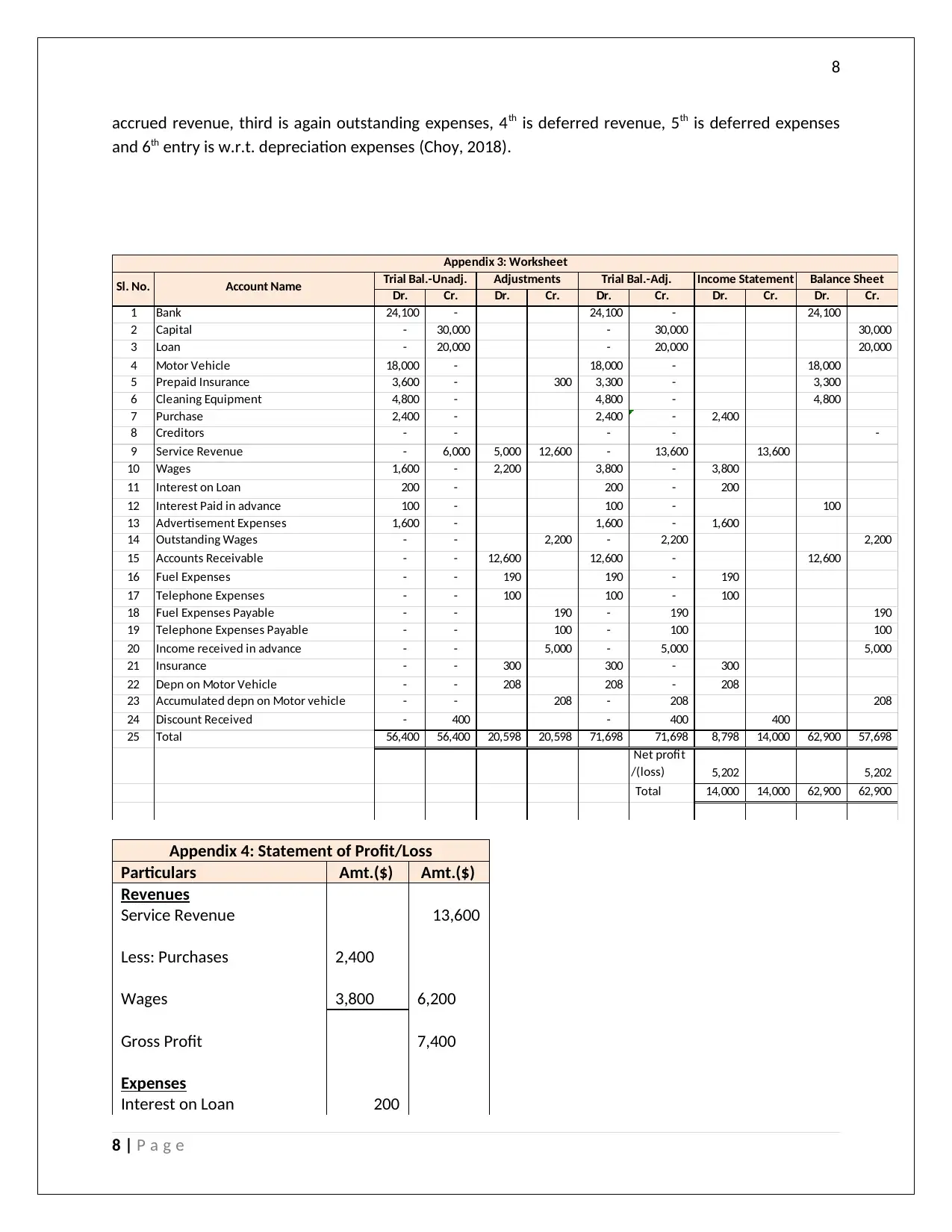
8
accrued revenue, third is again outstanding expenses, 4th is deferred revenue, 5th is deferred expenses
and 6th entry is w.r.t. depreciation expenses (Choy, 2018).
Dr. Cr. Dr. Cr. Dr. Cr. Dr. Cr. Dr. Cr.
1 Bank 24,100 - 24,100 - 24,100
2 Capital - 30,000 - 30,000 30,000
3 Loan - 20,000 - 20,000 20,000
4 Motor Vehicle 18,000 - 18,000 - 18,000
5 Prepaid Insurance 3,600 - 300 3,300 - 3,300
6 Cleaning Equipment 4,800 - 4,800 - 4,800
7 Purchase 2,400 - 2,400 - 2,400
8 Creditors - - - - -
9 Service Revenue - 6,000 5,000 12,600 - 13,600 13,600
10 Wages 1,600 - 2,200 3,800 - 3,800
11 Interest on Loan 200 - 200 - 200
12 Interest Paid in advance 100 - 100 - 100
13 Advertisement Expenses 1,600 - 1,600 - 1,600
14 Outstanding Wages - - 2,200 - 2,200 2,200
15 Accounts Receivable - - 12,600 12,600 - 12,600
16 Fuel Expenses - - 190 190 - 190
17 Telephone Expenses - - 100 100 - 100
18 Fuel Expenses Payable - - 190 - 190 190
19 Telephone Expenses Payable - - 100 - 100 100
20 Income received in advance - - 5,000 - 5,000 5,000
21 Insurance - - 300 300 - 300
22 Depn on Motor Vehicle - - 208 208 - 208
23 Accumulated depn on Motor vehicle - - 208 - 208 208
24 Discount Received - 400 - 400 400
25 Total 56,400 56,400 20,598 20,598 71,698 71,698 8,798 14,000 62,900 57,698
Net profit
/(loss) 5,202 5,202
Total 14,000 14,000 62,900 62,900
Account NameSl. No.
Appendix 3: Worksheet
Trial Bal.-Adj.Trial Bal.-Unadj. Adjustments Income Statement Balance Sheet
Appendix 4: Statement of Profit/Loss
Particulars Amt.($) Amt.($)
Revenues
Service Revenue 13,600
Less: Purchases 2,400
Wages 3,800 6,200
Gross Profit 7,400
Expenses
Interest on Loan 200
8 | P a g e
accrued revenue, third is again outstanding expenses, 4th is deferred revenue, 5th is deferred expenses
and 6th entry is w.r.t. depreciation expenses (Choy, 2018).
Dr. Cr. Dr. Cr. Dr. Cr. Dr. Cr. Dr. Cr.
1 Bank 24,100 - 24,100 - 24,100
2 Capital - 30,000 - 30,000 30,000
3 Loan - 20,000 - 20,000 20,000
4 Motor Vehicle 18,000 - 18,000 - 18,000
5 Prepaid Insurance 3,600 - 300 3,300 - 3,300
6 Cleaning Equipment 4,800 - 4,800 - 4,800
7 Purchase 2,400 - 2,400 - 2,400
8 Creditors - - - - -
9 Service Revenue - 6,000 5,000 12,600 - 13,600 13,600
10 Wages 1,600 - 2,200 3,800 - 3,800
11 Interest on Loan 200 - 200 - 200
12 Interest Paid in advance 100 - 100 - 100
13 Advertisement Expenses 1,600 - 1,600 - 1,600
14 Outstanding Wages - - 2,200 - 2,200 2,200
15 Accounts Receivable - - 12,600 12,600 - 12,600
16 Fuel Expenses - - 190 190 - 190
17 Telephone Expenses - - 100 100 - 100
18 Fuel Expenses Payable - - 190 - 190 190
19 Telephone Expenses Payable - - 100 - 100 100
20 Income received in advance - - 5,000 - 5,000 5,000
21 Insurance - - 300 300 - 300
22 Depn on Motor Vehicle - - 208 208 - 208
23 Accumulated depn on Motor vehicle - - 208 - 208 208
24 Discount Received - 400 - 400 400
25 Total 56,400 56,400 20,598 20,598 71,698 71,698 8,798 14,000 62,900 57,698
Net profit
/(loss) 5,202 5,202
Total 14,000 14,000 62,900 62,900
Account NameSl. No.
Appendix 3: Worksheet
Trial Bal.-Adj.Trial Bal.-Unadj. Adjustments Income Statement Balance Sheet
Appendix 4: Statement of Profit/Loss
Particulars Amt.($) Amt.($)
Revenues
Service Revenue 13,600
Less: Purchases 2,400
Wages 3,800 6,200
Gross Profit 7,400
Expenses
Interest on Loan 200
8 | P a g e
⊘ This is a preview!⊘
Do you want full access?
Subscribe today to unlock all pages.

Trusted by 1+ million students worldwide
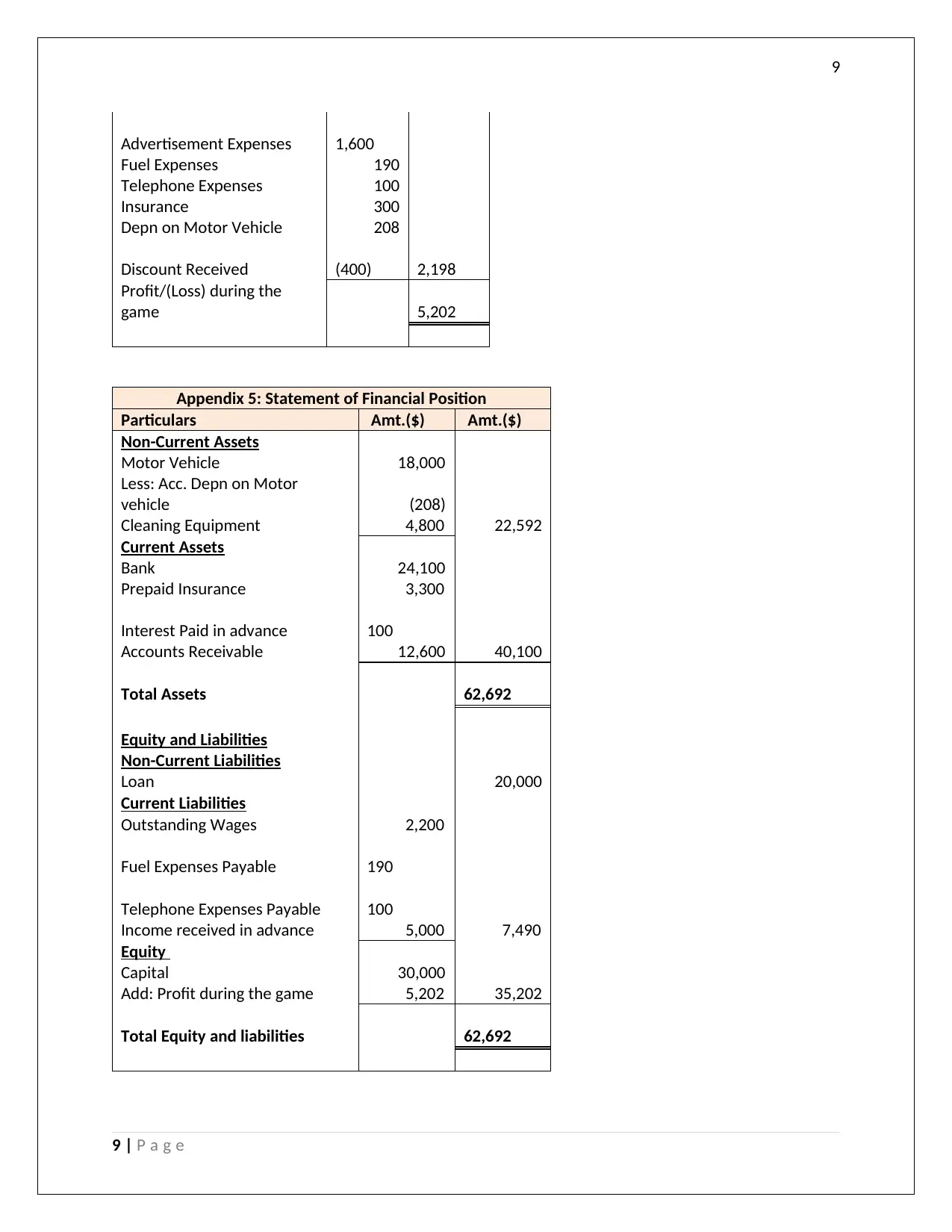
9
Advertisement Expenses 1,600
Fuel Expenses 190
Telephone Expenses 100
Insurance 300
Depn on Motor Vehicle 208
Discount Received (400) 2,198
Profit/(Loss) during the
game 5,202
Appendix 5: Statement of Financial Position
Particulars Amt.($) Amt.($)
Non-Current Assets
Motor Vehicle 18,000
Less: Acc. Depn on Motor
vehicle (208)
Cleaning Equipment 4,800 22,592
Current Assets
Bank 24,100
Prepaid Insurance 3,300
Interest Paid in advance 100
Accounts Receivable 12,600 40,100
Total Assets 62,692
Equity and Liabilities
Non-Current Liabilities
Loan 20,000
Current Liabilities
Outstanding Wages 2,200
Fuel Expenses Payable 190
Telephone Expenses Payable 100
Income received in advance 5,000 7,490
Equity
Capital 30,000
Add: Profit during the game 5,202 35,202
Total Equity and liabilities 62,692
9 | P a g e
Advertisement Expenses 1,600
Fuel Expenses 190
Telephone Expenses 100
Insurance 300
Depn on Motor Vehicle 208
Discount Received (400) 2,198
Profit/(Loss) during the
game 5,202
Appendix 5: Statement of Financial Position
Particulars Amt.($) Amt.($)
Non-Current Assets
Motor Vehicle 18,000
Less: Acc. Depn on Motor
vehicle (208)
Cleaning Equipment 4,800 22,592
Current Assets
Bank 24,100
Prepaid Insurance 3,300
Interest Paid in advance 100
Accounts Receivable 12,600 40,100
Total Assets 62,692
Equity and Liabilities
Non-Current Liabilities
Loan 20,000
Current Liabilities
Outstanding Wages 2,200
Fuel Expenses Payable 190
Telephone Expenses Payable 100
Income received in advance 5,000 7,490
Equity
Capital 30,000
Add: Profit during the game 5,202 35,202
Total Equity and liabilities 62,692
9 | P a g e
Paraphrase This Document
Need a fresh take? Get an instant paraphrase of this document with our AI Paraphraser
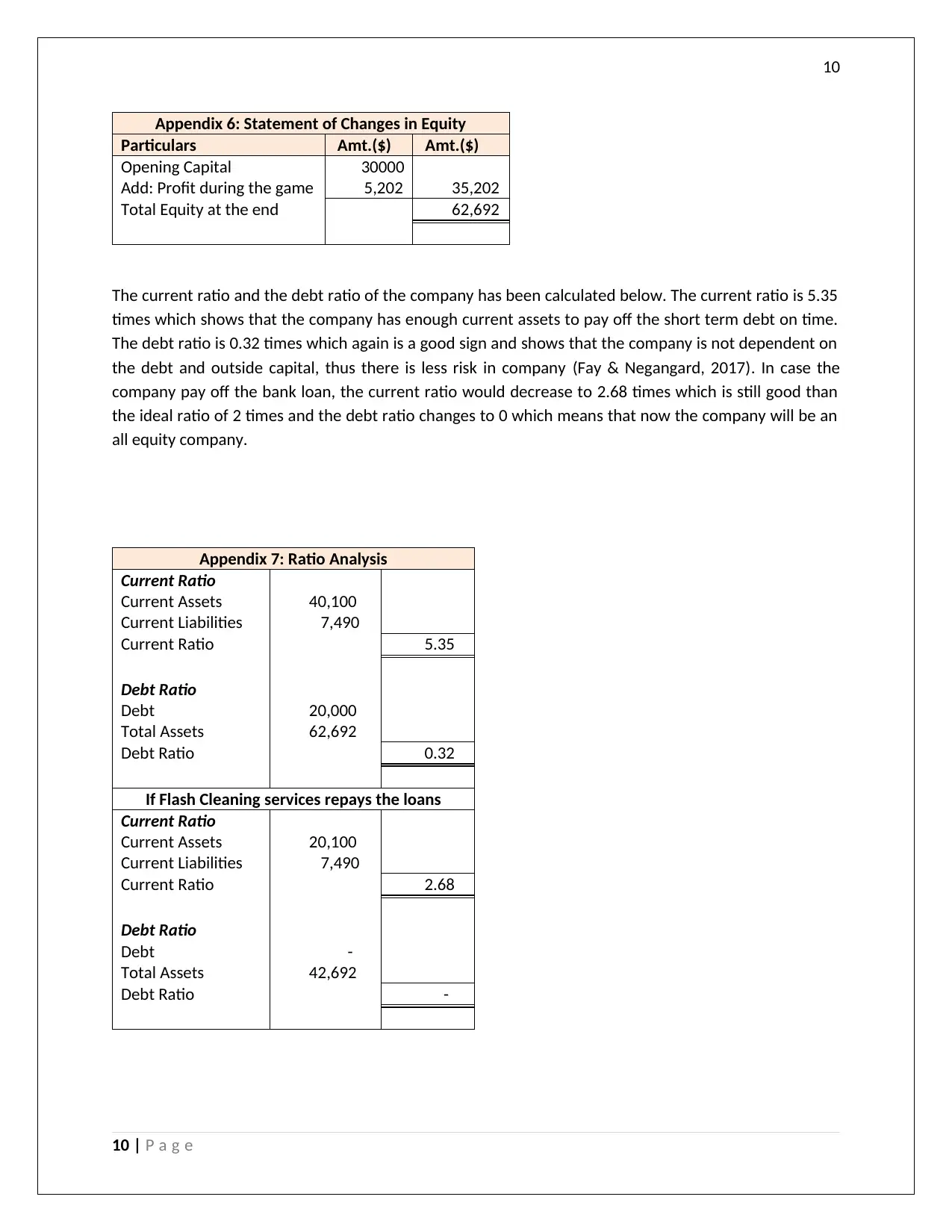
10
Appendix 6: Statement of Changes in Equity
Particulars Amt.($) Amt.($)
Opening Capital 30000
Add: Profit during the game 5,202 35,202
Total Equity at the end 62,692
The current ratio and the debt ratio of the company has been calculated below. The current ratio is 5.35
times which shows that the company has enough current assets to pay off the short term debt on time.
The debt ratio is 0.32 times which again is a good sign and shows that the company is not dependent on
the debt and outside capital, thus there is less risk in company (Fay & Negangard, 2017). In case the
company pay off the bank loan, the current ratio would decrease to 2.68 times which is still good than
the ideal ratio of 2 times and the debt ratio changes to 0 which means that now the company will be an
all equity company.
Appendix 7: Ratio Analysis
Current Ratio
Current Assets 40,100
Current Liabilities 7,490
Current Ratio 5.35
Debt Ratio
Debt 20,000
Total Assets 62,692
Debt Ratio 0.32
If Flash Cleaning services repays the loans
Current Ratio
Current Assets 20,100
Current Liabilities 7,490
Current Ratio 2.68
Debt Ratio
Debt -
Total Assets 42,692
Debt Ratio -
10 | P a g e
Appendix 6: Statement of Changes in Equity
Particulars Amt.($) Amt.($)
Opening Capital 30000
Add: Profit during the game 5,202 35,202
Total Equity at the end 62,692
The current ratio and the debt ratio of the company has been calculated below. The current ratio is 5.35
times which shows that the company has enough current assets to pay off the short term debt on time.
The debt ratio is 0.32 times which again is a good sign and shows that the company is not dependent on
the debt and outside capital, thus there is less risk in company (Fay & Negangard, 2017). In case the
company pay off the bank loan, the current ratio would decrease to 2.68 times which is still good than
the ideal ratio of 2 times and the debt ratio changes to 0 which means that now the company will be an
all equity company.
Appendix 7: Ratio Analysis
Current Ratio
Current Assets 40,100
Current Liabilities 7,490
Current Ratio 5.35
Debt Ratio
Debt 20,000
Total Assets 62,692
Debt Ratio 0.32
If Flash Cleaning services repays the loans
Current Ratio
Current Assets 20,100
Current Liabilities 7,490
Current Ratio 2.68
Debt Ratio
Debt -
Total Assets 42,692
Debt Ratio -
10 | P a g e
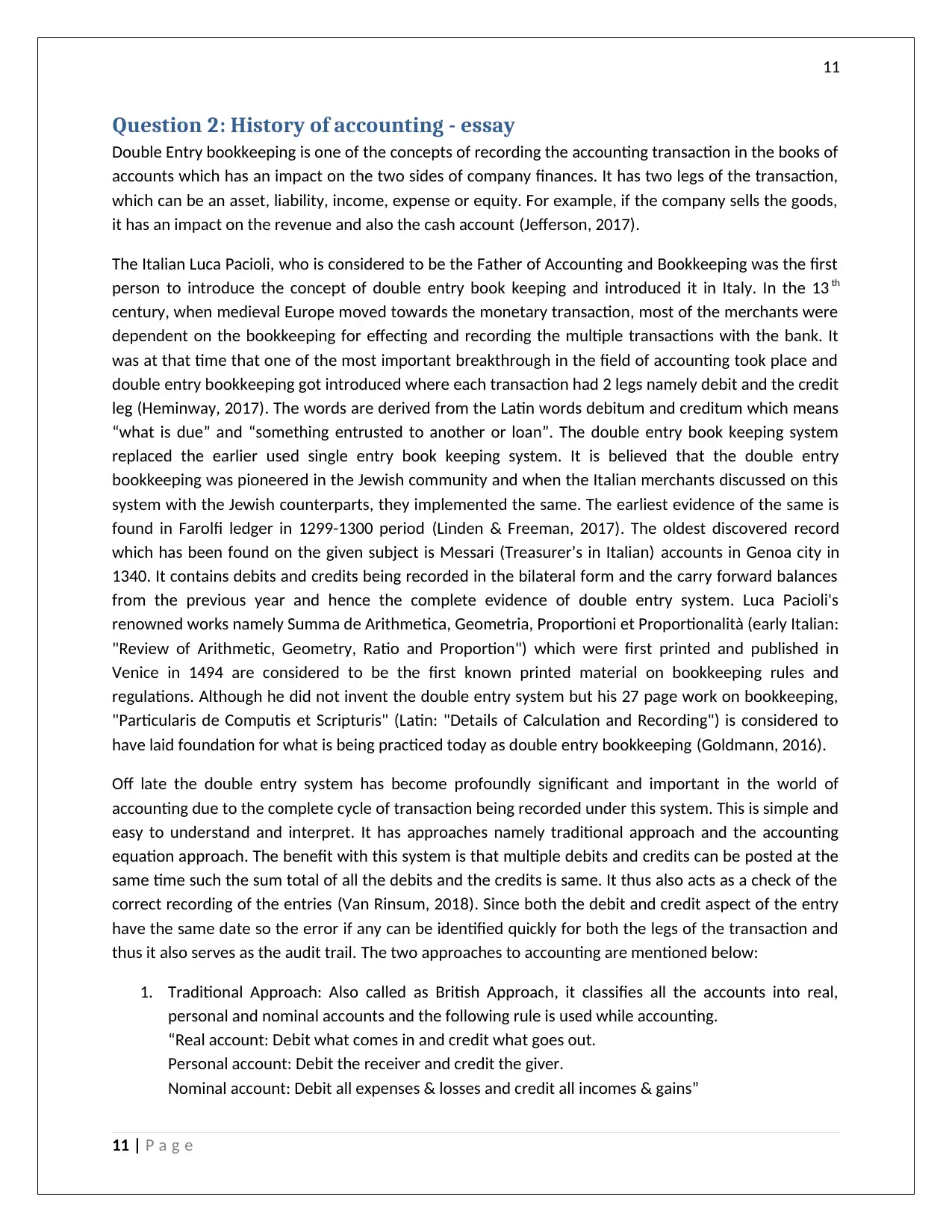
11
Question 2: History of accounting - essay
Double Entry bookkeeping is one of the concepts of recording the accounting transaction in the books of
accounts which has an impact on the two sides of company finances. It has two legs of the transaction,
which can be an asset, liability, income, expense or equity. For example, if the company sells the goods,
it has an impact on the revenue and also the cash account (Jefferson, 2017).
The Italian Luca Pacioli, who is considered to be the Father of Accounting and Bookkeeping was the first
person to introduce the concept of double entry book keeping and introduced it in Italy. In the 13 th
century, when medieval Europe moved towards the monetary transaction, most of the merchants were
dependent on the bookkeeping for effecting and recording the multiple transactions with the bank. It
was at that time that one of the most important breakthrough in the field of accounting took place and
double entry bookkeeping got introduced where each transaction had 2 legs namely debit and the credit
leg (Heminway, 2017). The words are derived from the Latin words debitum and creditum which means
“what is due” and “something entrusted to another or loan”. The double entry book keeping system
replaced the earlier used single entry book keeping system. It is believed that the double entry
bookkeeping was pioneered in the Jewish community and when the Italian merchants discussed on this
system with the Jewish counterparts, they implemented the same. The earliest evidence of the same is
found in Farolfi ledger in 1299-1300 period (Linden & Freeman, 2017). The oldest discovered record
which has been found on the given subject is Messari (Treasurer’s in Italian) accounts in Genoa city in
1340. It contains debits and credits being recorded in the bilateral form and the carry forward balances
from the previous year and hence the complete evidence of double entry system. Luca Pacioli's
renowned works namely Summa de Arithmetica, Geometria, Proportioni et Proportionalità (early Italian:
"Review of Arithmetic, Geometry, Ratio and Proportion") which were first printed and published in
Venice in 1494 are considered to be the first known printed material on bookkeeping rules and
regulations. Although he did not invent the double entry system but his 27 page work on bookkeeping,
"Particularis de Computis et Scripturis" (Latin: "Details of Calculation and Recording") is considered to
have laid foundation for what is being practiced today as double entry bookkeeping (Goldmann, 2016).
Off late the double entry system has become profoundly significant and important in the world of
accounting due to the complete cycle of transaction being recorded under this system. This is simple and
easy to understand and interpret. It has approaches namely traditional approach and the accounting
equation approach. The benefit with this system is that multiple debits and credits can be posted at the
same time such the sum total of all the debits and the credits is same. It thus also acts as a check of the
correct recording of the entries (Van Rinsum, 2018). Since both the debit and credit aspect of the entry
have the same date so the error if any can be identified quickly for both the legs of the transaction and
thus it also serves as the audit trail. The two approaches to accounting are mentioned below:
1. Traditional Approach: Also called as British Approach, it classifies all the accounts into real,
personal and nominal accounts and the following rule is used while accounting.
“Real account: Debit what comes in and credit what goes out.
Personal account: Debit the receiver and credit the giver.
Nominal account: Debit all expenses & losses and credit all incomes & gains”
11 | P a g e
Question 2: History of accounting - essay
Double Entry bookkeeping is one of the concepts of recording the accounting transaction in the books of
accounts which has an impact on the two sides of company finances. It has two legs of the transaction,
which can be an asset, liability, income, expense or equity. For example, if the company sells the goods,
it has an impact on the revenue and also the cash account (Jefferson, 2017).
The Italian Luca Pacioli, who is considered to be the Father of Accounting and Bookkeeping was the first
person to introduce the concept of double entry book keeping and introduced it in Italy. In the 13 th
century, when medieval Europe moved towards the monetary transaction, most of the merchants were
dependent on the bookkeeping for effecting and recording the multiple transactions with the bank. It
was at that time that one of the most important breakthrough in the field of accounting took place and
double entry bookkeeping got introduced where each transaction had 2 legs namely debit and the credit
leg (Heminway, 2017). The words are derived from the Latin words debitum and creditum which means
“what is due” and “something entrusted to another or loan”. The double entry book keeping system
replaced the earlier used single entry book keeping system. It is believed that the double entry
bookkeeping was pioneered in the Jewish community and when the Italian merchants discussed on this
system with the Jewish counterparts, they implemented the same. The earliest evidence of the same is
found in Farolfi ledger in 1299-1300 period (Linden & Freeman, 2017). The oldest discovered record
which has been found on the given subject is Messari (Treasurer’s in Italian) accounts in Genoa city in
1340. It contains debits and credits being recorded in the bilateral form and the carry forward balances
from the previous year and hence the complete evidence of double entry system. Luca Pacioli's
renowned works namely Summa de Arithmetica, Geometria, Proportioni et Proportionalità (early Italian:
"Review of Arithmetic, Geometry, Ratio and Proportion") which were first printed and published in
Venice in 1494 are considered to be the first known printed material on bookkeeping rules and
regulations. Although he did not invent the double entry system but his 27 page work on bookkeeping,
"Particularis de Computis et Scripturis" (Latin: "Details of Calculation and Recording") is considered to
have laid foundation for what is being practiced today as double entry bookkeeping (Goldmann, 2016).
Off late the double entry system has become profoundly significant and important in the world of
accounting due to the complete cycle of transaction being recorded under this system. This is simple and
easy to understand and interpret. It has approaches namely traditional approach and the accounting
equation approach. The benefit with this system is that multiple debits and credits can be posted at the
same time such the sum total of all the debits and the credits is same. It thus also acts as a check of the
correct recording of the entries (Van Rinsum, 2018). Since both the debit and credit aspect of the entry
have the same date so the error if any can be identified quickly for both the legs of the transaction and
thus it also serves as the audit trail. The two approaches to accounting are mentioned below:
1. Traditional Approach: Also called as British Approach, it classifies all the accounts into real,
personal and nominal accounts and the following rule is used while accounting.
“Real account: Debit what comes in and credit what goes out.
Personal account: Debit the receiver and credit the giver.
Nominal account: Debit all expenses & losses and credit all incomes & gains”
11 | P a g e
⊘ This is a preview!⊘
Do you want full access?
Subscribe today to unlock all pages.

Trusted by 1+ million students worldwide
1 out of 17
Related Documents
Your All-in-One AI-Powered Toolkit for Academic Success.
+13062052269
info@desklib.com
Available 24*7 on WhatsApp / Email
![[object Object]](/_next/static/media/star-bottom.7253800d.svg)
Unlock your academic potential
Copyright © 2020–2025 A2Z Services. All Rights Reserved. Developed and managed by ZUCOL.





